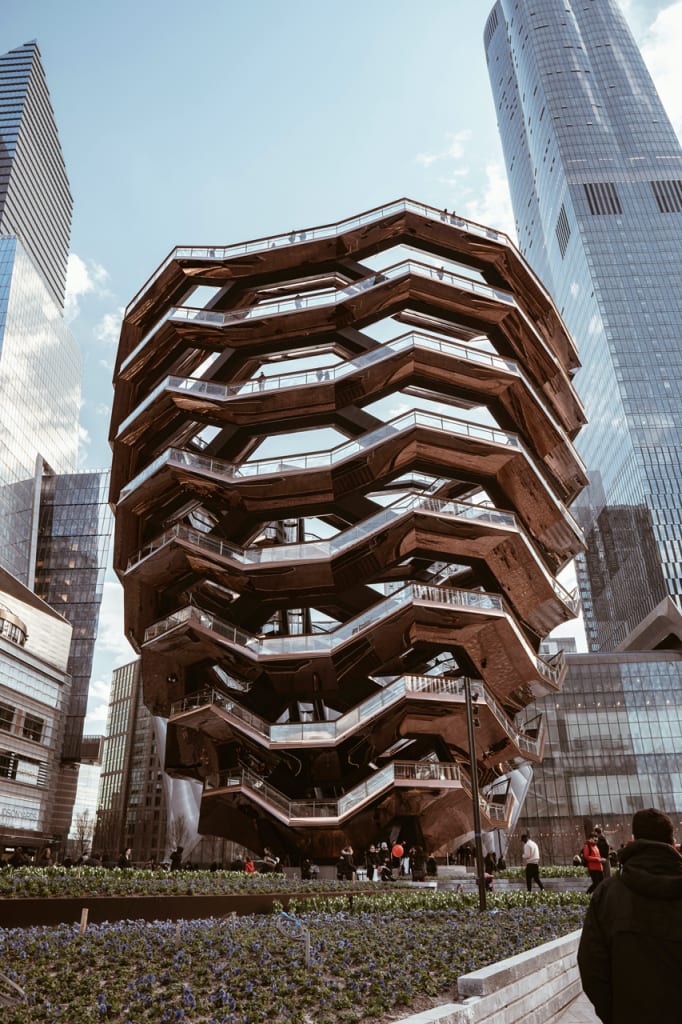The Vessel—the $200-million sculpture-to-nowhere developed by billionaire Stephen Ross’s real estate firm Related—has reopened in Hudson Yards, cloaked in a thin metal mesh. The netting is Related’s response to the four people who have jumped and died from the sculpture since it first opened in March 2019.
It is also a perfect metaphor for what the Vessel has always been: a zoo, which now has a cage to match.
Lost opportunities and lost lives
Even before the Vessel opened, critics rightfully predicted people would jump from the sculpture. Reportedly, the sculpture’s designer, Thomas Heatherwick, had designed higher safety barriers but the developer never installed them.
The Vessel first closed in January 2021, after three people jumped by suicide. It reopened a few months later, with increased security, a “buddy system” that would ensure that nobody goes up alone, and a $10 ticket fee. But on July 29—only two months after Related implemented those mitigation techniques—a 14-year-old boy jumped to his death in front of his parents and his little sister. The Vessel closed again.

While the death trap stood empty as a spectre, many shared opinions regarding its fate. Some called for it to be dismantled. Others said it should remain closed and act as a memorial. But Related had other plans. “Vessel is an iconic New York City experience that was always designed to be entered and explored,” Related’s CEO Jeff Blau, told Fast Company in a written statement. “Not a day goes by that we don’t have visitors walking up to our staff asking where they can buy tickets and when it will reopen.” A Related spokesperson said that more than 10,000 tickets were purchased in the opening hours on Monday.

A dizzying experience
When I visited on Wednesday, around noon, I shared the sculpture with maybe 20 other people, most of whom had brought their selfie sticks and posed against the copper-clad railings, seemingly unfussed with the steel mesh draped across the background of their photos.
The mesh isn’t attached to the sculpture itself, which would make sense if the Vessel was a landmarked structure that couldn’t be touched. Instead, Related’s team of engineers and designers, working closely with Heatherwick Studio, built a separate metal frame (rendered in grey, not copper) that supports the mesh and juts out from the railings like the armature of a circus tent.

Only about half of the sculpture is covered in netting, meaning only one side is accessible to visitors. It’s the side facing The Shed and the upscale shopping mall next door, instead of the side where you can steal a view of the Hudson River or the nearby park. Related did not offer an explanation for this decision. My guess is they kept one side mesh-free (and therefore inaccessible) so the sculpture could perform the only job it ever had: to look good on Instagram.
Related said they “studied empirical evidence from other locations where similar incidents have occurred,” which lead to the construction of the steel mesh. But from within, this partial netting results in a dizzying experience that I can only liken to that of a trapped bird trying to escape from its cage. As I walked up and down and up and down the sculpture, I kept hitting dead ends in the form of floor-to-ceiling mesh stretched taut across a landing. What used to be a free-flowing—if pointless—journey has become a sad and scripted excursion.

Will the mesh prevent more suicides?
But aesthetics aside, what matters the most at this point, is whether this mesh will, indeed, save lives. Many researchers agree that restricting access is likely to deter people, particularly the younger population, from jumping. “If the access to a certain place is restricted, they rarely switch location,” Charlotta Thodelius, a professor of criminology who has been researching suicidal situations in outdoor public places, told me when the Vessel closed back in 2021. This, coupled with the fact that every region has “suicide hot spots” where people are most likely to jump, could mean that the mesh will deter people from jumping again. For example, the Golden Gate Bridge’s anti-suicide nets, which were installed last year, have already saved lives.
But at the Vessel, the mesh would only work if every gap in the structure was covered in it. Except it isn’t. According to Ed Kopel, an architect and founder of a new suicide prevention nonprofit called Raise the Rail, the netting should start lower than it does. Indeed, the mesh doesn’t start until 30 or so feet above ground—or the equivalent of falling from a three-story building—which we know is high enough for someone to die. Kopel also points out there are no suicide hotline phones or signs, which studies say can prove effective. “It’s a scary, sinister structure,” he says. “My best guess is that there will be more attempts.”


